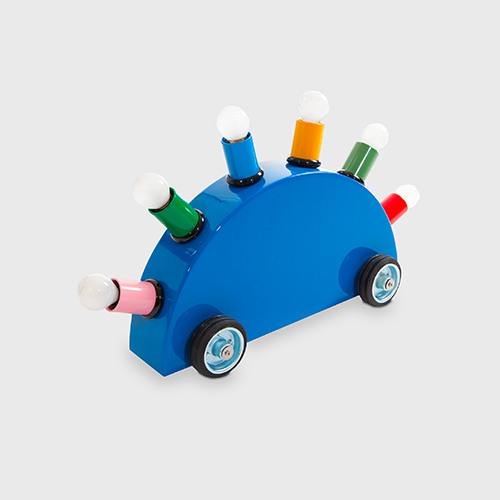Umeda & Memphis Exhibition

The manifesto
Born under the banner of emotion, this exhibition at the confluence of the senses is a real tribute to Masanori Umeda and the Memphis movement.
Just 40 years ago, Ettore Sottsass and his gang were shaking up the history of design with the first Memphis collection. Presented in Milan in September 1981, it surprised and touched the public with its strength and intensity.
This joyful movement, uninhibited, full of humour and mockery, would add colour, extravagance, joie de vivre and madness in an era that was starting to seriously lack it.
The discovery of "Night Tales", the last collection by Masanori Umeda, one of the star Memphis designers, inspired here by his iconic Tawaraya boxing ring, the ultimate symbol of the movement, was a real shock, and these creations have touched us deeply. This strong emotion echoed what was expressed in 1981.
From the need to share it and create a dialogue between the designer's new works and the movement’s historical pieces was born the exhibition “Umeda and Memphis, sensory dialogues”. The Night Tales collection created by the Japanese designer at the age of 80 is an important testimony. It includes pieces produced in very limited series and is presented for the first time in France, exclusively at the Made In Design gallery.
This rich, immersive exhibition, with its intersecting perspectives, takes us back to the history of this legendary movement. It invites us to discover exceptional pieces rarely exhibited to the public, like the Tartar console by Ettore Sottsass, and joyful, playful, even ironic pieces such as the Roma armchair by Marco Zanini.
The scenography includes fabrics with vibrant, explosive graphics by Nathalie du Pasquier, Ettore Sottsass and George Sowden. A very special place is given to female designers, essential players in this avant-garde movement, whose creations are among the centrepieces.
In this way, multiple dialogues are created with energy and intensity between the artists, their creations and the public.
An event that echoes the “Sottsass, the magical object” exhibition currently on view at the Pompidou Centre.
Sensory design

Masanori Umeda
Guest of honor

Born in 1941 near Yokohama, Masanori Umeda began studying design in Tokyo in his late teens. In the mid-1960s, as a very young graduate of the Kuwasawa school, he decided to leave the archipelago and go to Milan, the city where the maestri were living, whom he discovered in the pages of the review Domus, edited by Gio Ponti. So he set off on a ferry to Marseille and then reached the Lombard capital, where he first found a place in the studio of brothers Achille and Pier Giacomo Castiglioni. In the early 1970s, he left them to join the technological adventure Olivetti, where he met Ettore Sottsass, who then ran the electronics manufacturer's Milan design office. In 1981, when Umeda returned to live in Japan, Sottsass called on him to take part in the very first collection by the Memphis movement. An experience that would make a lasting mark on his career. He then turned to a more figurative design in the 90s with his flower-inspired seats for Italian designer EDRA. He became a teacher and consultant, but continued to design objects with strong sensoriality, which expressed the Japanese art of symbiosis with nature and the poetry that arises from it, as demonstrated by his “Night Tales” collection, developed while he’d just celebrated his 80th birthday.
Night Tales Collection
For the first time in France, the Made In Design gallery exclusively presents "Night Tales", an exceptional collection that projects us into the sensory world of Masanori Umeda. His creative energy is deployed around two series with Utamaro, items of furniture inspired by his famous Tawaraya boxing ring, an emblem of Memphis, and reissues of objects designed in the 80s.
Utamaro
The Utamaro collection is inspired by the erotic rituals, imagery and interiors of the Edo era (1600-1868), as immortalised by Japanese painter Kitagawa Utamaro (1753-1806). It offers an aesthetic reminiscent of the famous Tawaraya boxing ring with its tatami mats and black and white stripes, a signature Memphis motif. The uniqueness of this collection comes from these superb silk cushions with their flamboyant shades, made according to ancestral methods of dyeing kimonos.
The 1980s
"Night Tales" includes a second series of creations that were designed in 1982, during the Memphis period, and recently reissued in limited copies. The Medusa table and Animal armchair reveal a singular language, as if they come from a tale in which we come across strange animals.
Memphis, a legendary movement

Avant-garde mockery
A creative bunch of friends

A movement born from a group of friends driven by a crazy desire to overturn the codes of an overly sensible design, which would shake up design at the end of the 20th century. Unveiled at the 1981 Milan Salon, the first collection by these idealists was shocking: improbable shapes, furniture covered with laminate with abundant geometric patterns… By churning up post-modernist precepts, Memphis played a central role in the fruitful reconciliation between design and art. For the first time, design was inspired by the street and radically opposed convention. For nearly seven years, this joyful movement, filled with humour and mockery, brought joie de vivre and madness into an era that was beginning to seriously lack it.

Ettore Sottsass
Iconic founder

After training as an architect and a detour through painting, he produced his first furniture in 1947. He also pursued a career in industrial design by creating products such as the Valentine typewriter for Olivetti. At the end of the 1970s, after a detour through the experimental Alchimia movement, it was Memphis that brought him to the attention of the general public. He founded this movement at the age of 64 and had the foresight to unite around him a group of young designers with whom he would revolutionise design at the end of the 20th century. A polymorphic designer, Ettore Sottsass (1917-2007) was always keen to produce objects loaded with a surfeit of soul. Throughout his life, he went through several periods and touched multiple mediums, but his favourite material was ceramics! This tireless adventurer was inspired by his many travels (India, California, etc.) to create pieces fed by oriental spiritualities and pop culture.
Rarely seen pieces
The intention of this exhibition was also to present lesser-known or even little-known pieces to broaden understanding of the richness of the Memphis movement and offer visitors the joy of discovering important, remarkable works. Discover extremely rare pieces by Ettore Sottsass such as the Tartar console, which seems to be straight out of "the smoky urban atmospheres (…) of Blade Runner", as Barbara Radice commented, or the sculptural Mandarin table characterised by its imposing, disproportionate table leg.

George J. Sowden
Design to experience

An English designer and architect living in Milan since the 1970s, George J. Sowden first worked with Ettore Sottsass at Olivetti before embarking on the Memphis adventure. His aesthetic, defying the austerity of the time, remains omnipresent in his work. Interested in research design and collaboration with craft companies, he founded his own brand in 2010.
A feminine movement
Memphis was a forward-thinking movement, both creatively and socially. At a time when the world of design was a very masculine affair, Ettore Sottsass took three young women along with him: Nathalie du Pasquier, Martine Bedin and Maria Sanchez. They were involved in founding the movement to the same extent as the men.

Nathalie Du Pasquier

The designer travelled across sub-Saharan Africa before moving to Milan in the late 1970s. Within Memphis, she designed furniture and above all produced designs inspired by her travels to create all-over patterns that would make the movement unique, and went on to dress the fabrics and laminated surfaces of objects in the collections. Like a true artist, her style left its mark on history with its characteristic assemblages. In close collaboration with her companion George J. Sowden, she continues to create rugs, ceramics and other objects for Memphis Milano / Post Design.

Martine Bedin

After her studies at the Beaux-Arts in Bordeaux, Martine Bedin went to Florence where she became associated with what was then the avant-garde of Italian architecture: Superstudio. Then she went to Milan, met Sottsass and became one of the founding members of Memphis. Originally behind the Super lamp, which eulogises the carefree, she reaffirmed one of the collective's credos: the emotional as a new functional. Martine Bedin lives in Paris and teaches design at the Ecole Camondo.

Maria Sanchez

The most discreet of the Memphis women is Argentina’s Maria Sanchez. Having arrived late in the group following her meeting with Ettore Sottsass in 1985, she designed the smallest item in the catalogue, which is also one of the best known: the Squash ashtray, which has become one of the icons of the movement with its motley assemblage of colourful, geometric shapes. Now a strategic design consultant for numerous companies, she is also a university researcher and lives in Argentina.
Graphic revolution
Textiles, which are not widely displayed, have been a real medium of creative expression for Nathalie Du Pasquier, George J. Sowden and Ettore Sottsass. We bring you the most beautiful examples with the iconic graphics and colours of the movement, through a display that plunges the visitor into an immersive scenography.

Nathalie Du Pasquier
(1981) Burundi

Nathalie Du Pasquier
(1983) Cerchio

Nathalie Du Pasquier
(1982) Zaïre

Ettore Sottsass
(1983) Letraset

Ettore Sottsass
(1983) Rete

George J. Sowden
(1983) Triangolo

George J. Sowden
(1983) Quadro
The other exhibits
Useful information
Made In Design Gallery
Printemps Haussmann
6th floor Printemps Womenwear
64 Boulevard Haussmann
75009 Paris
Opening times
Every day from 11.00am to 7.00pm.
Until 8 January 2022
Acknowledgements & partnerships
Masanori Umeda
Designer
Nanae Umeda
Designer
Alberto Bianchi Albrici
CEO of Memphis-Milano
Roger von Bary
Memphis-Milano agent
Brigitte Fitoussi
Writer specialising in the Memphis movement
Marie Godfrain
Journalist and teacher in design history


























































